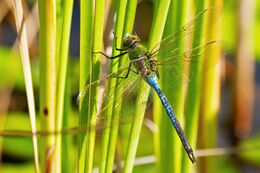Green Darner: Difference between revisions
No edit summary |
No edit summary |
||
| Line 15: | Line 15: | ||
==Habitat== | ==Habitat== | ||
Since the Green Darner is a migratory insect it can be found in many varying habitats [2]. | Since the Green Darner is a migratory insect it can be found in many varying habitats [2]. Adult Darners are typically found in riparian habitats, because they heavily relay on water for reproduction [2]. Sometimes Darners will live on the water they original spawned from [2]. While migrating they will make use of coast lines and beaches for temporary habitat [2]. At night they are often found resting in herbaceous plants [2]. During the day they may forage for food in forests, grasslands, or deserts, but must be near a water source at all times [2]. | ||
==Diet== | ==Diet== | ||
==Reproduction== | |||
==References== | ==References== | ||
Revision as of 14:13, 9 May 2022
The Common Green Darner, also known as Anax Junis, is a type of insect more commonly known as a dragonfly [1]. This species is considered to be larger than most, and can be spotted flying over top of open fields [2]. They are referred to as 'Darners' because it was old belief that dragonflies were the 'Devil's Darning Needles', and that they could sew people's mouths shut [3].

Description

The Green Darner can grow up to 8cm in length, having a short thorax and a long skinny abdomen [2]. Both males and females have large green eyes for navigating and hunting, but males tend to have duller colored eyes [2]. As they are considered insects, they possess six legs, 3 on each side [2]. They posses four translucent yellowish-clear wings that connect to their thorax [2]. All Green Darner's have a bright green thorax that connects to two wings on each side [1]. Males and females are typically distinguished by their abdomen color [1]. Female Darner's have a dark reddish brown abdomen, whereas males will have strictly bright blue abdomens [2].
Distribution

The Green Darner is one of the most prevalent dragonfly species in North America [1]. They are found all across the United States, and populations are even found in Southern Canada and Mexico [2]. During the winter season in the Northern Hemisphere, Darners will migrate south to survive cold conditions [2]. During these months populations can be found in the Yucatan, Belize, Veracruz, Hawaii, and Tahiti [2]. During migration they are often blown off course by the wind and can end up in random regions of the world, but so far have not established any invasive populations [2].
Habitat
Since the Green Darner is a migratory insect it can be found in many varying habitats [2]. Adult Darners are typically found in riparian habitats, because they heavily relay on water for reproduction [2]. Sometimes Darners will live on the water they original spawned from [2]. While migrating they will make use of coast lines and beaches for temporary habitat [2]. At night they are often found resting in herbaceous plants [2]. During the day they may forage for food in forests, grasslands, or deserts, but must be near a water source at all times [2].
Diet
Reproduction
References
[1] Common Green Darner | Department of Entomology. (n.d.). . https://entomology.umn.edu/common-green-darner.
[2] Miner, A. (n.d.). Anax junius. https://animaldiversity.org/accounts/Anax_junius/.
[3] Not Green Darners (Family Aeshnidae). 2011, October 11. .
Images:
1. https://www.istockphoto.com/search/2/image?phrase=green+darner
2. https://www.enchantedlearning.com/subjects/insects/dragonfly/Dragonflyprintout.shtml